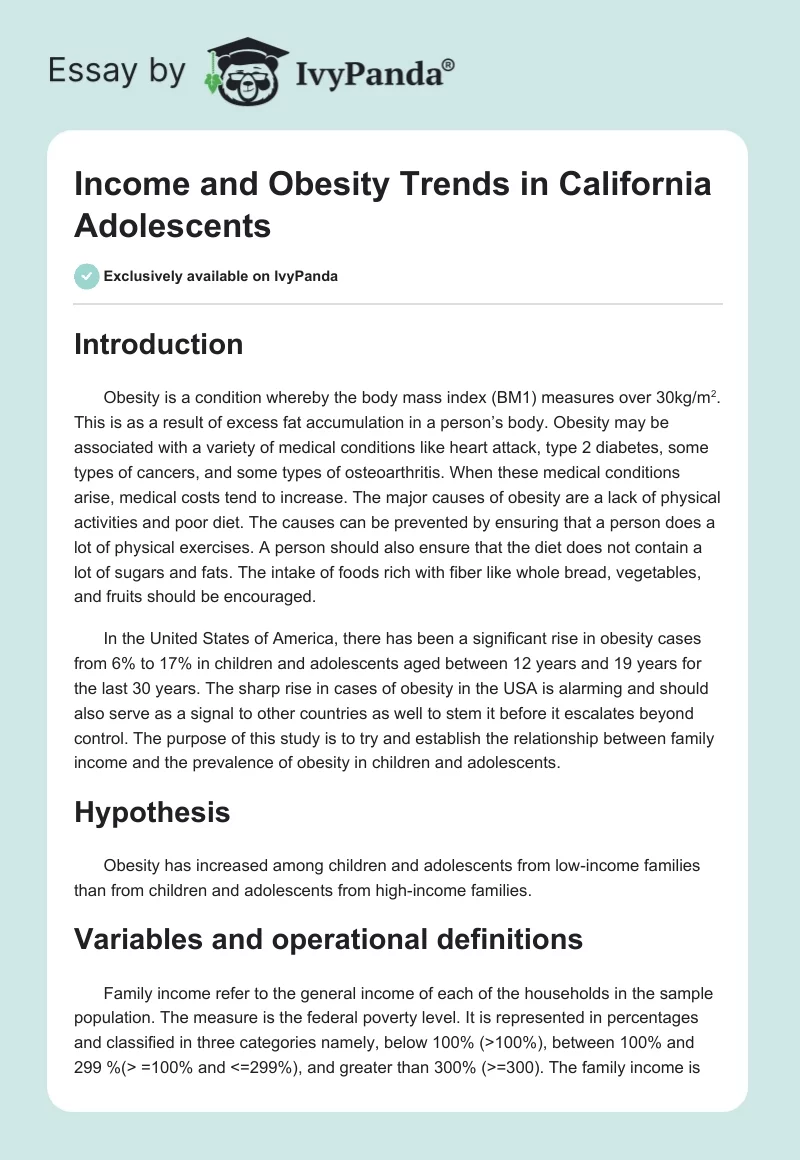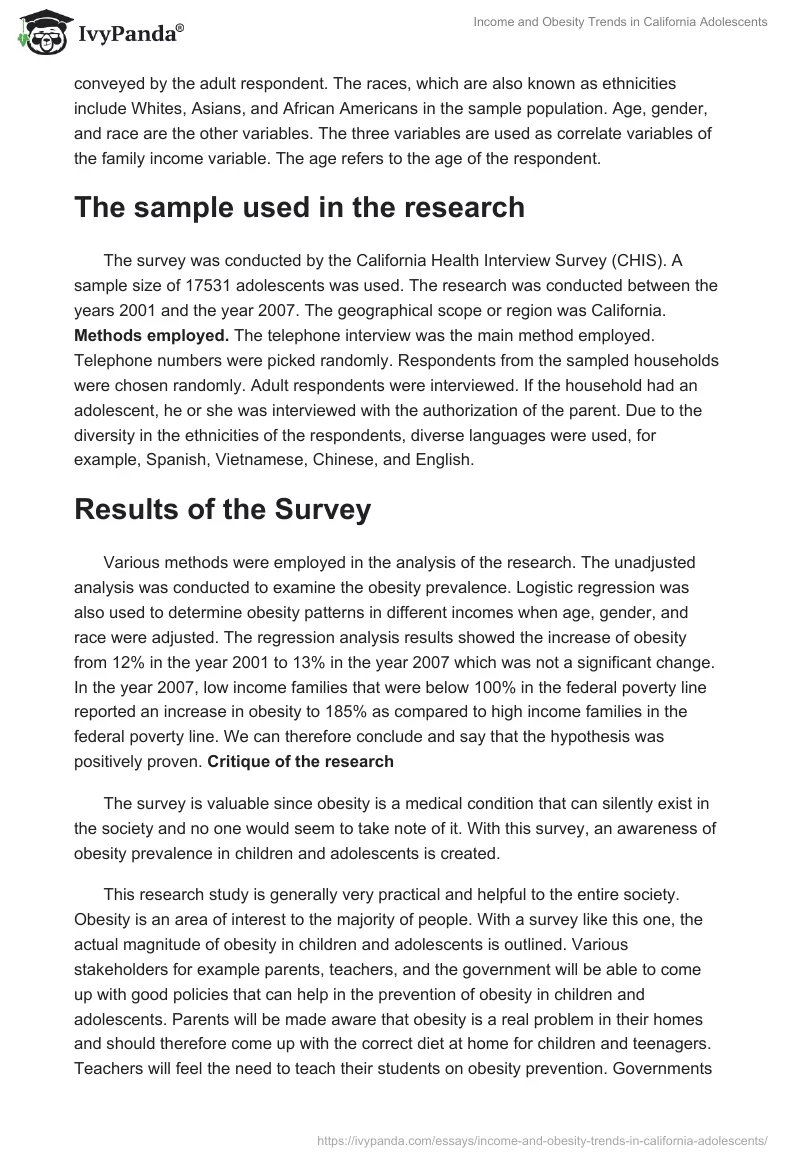Introduction
Obesity is a condition whereby the body mass index (BM1) measures over 30kg/m2. This is as a result of excess fat accumulation in a person’s body. Obesity may be associated with a variety of medical conditions like heart attack, type 2 diabetes, some types of cancers, and some types of osteoarthritis. When these medical conditions arise, medical costs tend to increase. The major causes of obesity are a lack of physical activities and poor diet. The causes can be prevented by ensuring that a person does a lot of physical exercises. A person should also ensure that the diet does not contain a lot of sugars and fats. The intake of foods rich with fiber like whole bread, vegetables, and fruits should be encouraged.
In the United States of America, there has been a significant rise in obesity cases from 6% to 17% in children and adolescents aged between 12 years and 19 years for the last 30 years. The sharp rise in cases of obesity in the USA is alarming and should also serve as a signal to other countries as well to stem it before it escalates beyond control. The purpose of this study is to try and establish the relationship between family income and the prevalence of obesity in children and adolescents.
Hypothesis
Obesity has increased among children and adolescents from low-income families than from children and adolescents from high-income families.
Variables and operational definitions
Family income refer to the general income of each of the households in the sample population. The measure is the federal poverty level. It is represented in percentages and classified in three categories namely, below 100% (>100%), between 100% and 299 %(> =100% and <=299%), and greater than 300% (>=300). The family income is conveyed by the adult respondent. The races, which are also known as ethnicities include Whites, Asians, and African Americans in the sample population. Age, gender, and race are the other variables. The three variables are used as correlate variables of the family income variable. The age refers to the age of the respondent.
The sample used in the research
The survey was conducted by the California Health Interview Survey (CHIS). A sample size of 17531 adolescents was used. The research was conducted between the years 2001 and the year 2007. The geographical scope or region was California. Methods employed. The telephone interview was the main method employed. Telephone numbers were picked randomly. Respondents from the sampled households were chosen randomly. Adult respondents were interviewed. If the household had an adolescent, he or she was interviewed with the authorization of the parent. Due to the diversity in the ethnicities of the respondents, diverse languages were used, for example, Spanish, Vietnamese, Chinese, and English.
Results of the Survey
Various methods were employed in the analysis of the research. The unadjusted analysis was conducted to examine the obesity prevalence. Logistic regression was also used to determine obesity patterns in different incomes when age, gender, and race were adjusted. The regression analysis results showed the increase of obesity from 12% in the year 2001 to 13% in the year 2007 which was not a significant change. In the year 2007, low income families that were below 100% in the federal poverty line reported an increase in obesity to 185% as compared to high income families in the federal poverty line. We can therefore conclude and say that the hypothesis was positively proven. Critique of the research
The survey is valuable since obesity is a medical condition that can silently exist in the society and no one would seem to take note of it. With this survey, an awareness of obesity prevalence in children and adolescents is created.
This research study is generally very practical and helpful to the entire society. Obesity is an area of interest to the majority of people. With a survey like this one, the actual magnitude of obesity in children and adolescents is outlined. Various stakeholders for example parents, teachers, and the government will be able to come up with good policies that can help in the prevention of obesity in children and adolescents. Parents will be made aware that obesity is a real problem in their homes and should therefore come up with the correct diet at home for children and teenagers. Teachers will feel the need to teach their students on obesity prevention. Governments can organize obesity awareness campaigns. They can also stress the need to incorporate extra curricula act ivies in the schools and college syllabuses.
The geographical scope can be widened to include other states in the United States of America. The target groups should also be made to include adults and the elderly. A survey to find out the increase in the number of people suffering the medical conditions like the type 2 diabetes which is as a result of obesity should be done. These will give the stakeholders a clearer picture of the overall obesity prevalence.
The research was generally well done. Households were randomly selected meaning the selection criteria used did not discriminate any households (Babey et al 2154). This ensured that there were no biases in the selection criteria. Young respondents were interviewed with the permission of the adults. This showed respect and no violation of individual rights. A few improvements on the research would have been made. The data collection method used was that of telephone interviews. This was an expensive method. Communication between the researcher and the respondent was not face to face. The accuracy of the information may be challenged. Oral face to face interviews could have been employed. Questionnaires could also have been used to aid in data collection. The sample population was quite diminutive. If a larger sample population had been used, it would have reflected a wider portion of the entire population of the USA. The age variable was as reported by the respondents. Accuracy on the same may not be very well determined.
My recommendations on the next step of this research would be that all stakeholders in this area should be incorporated in the exercise. They should thoroughly scrutinize the results of the survey. With the help of experts, a report on the survey should be drawn. Thereafter, recommendations on the same should be made. A team should be constituted to foresee the implementation of the said recommendations. Another survey should be carried out to determine if there has been any improvement on the obesity prevalence on children and adolescents.
Works Cited
Babey et al. “Income Disparities in Obesity Trends Among California Adolescents”, American Journal of Public Health 100.11(2010):2149-2155.Print.


